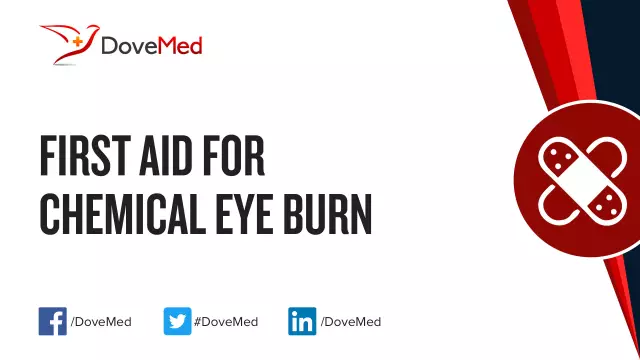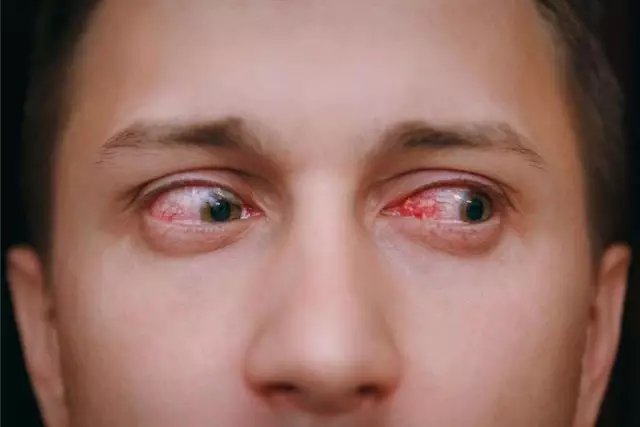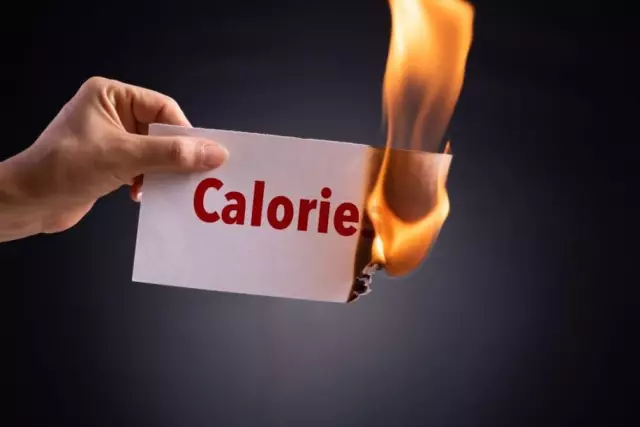- Author Rachel Wainwright [email protected].
- Public 2023-12-15 07:39.
- Last modified 2025-11-02 20:14.
Eye burn

An eye burn is an injury to the anterior part of the eye that occurs as a result of excessive temperature, chemical or radiation exposure to the eye. The most common are thermal burns by burning particles, chemical burns and welding burns. In case of eye burns, the conjunctiva and the skin of the eyelids suffer first, then the cornea, lacrimal ducts and deeper structures of the eye, right down to its posterior parts.
Eye burns
There are four degrees of eye burn.
- First degree. The skin of the eyelids is edematous, hyperemic, the conjunctiva is hyperemic, damage to only the upper layer of the cornea is edema of the epithelial layer or its erosion.
- Second degree. Blisters on the skin of the eyelids, whitish areas of dead tissue on the mucous membrane, the cornea is cloudy. Several superficial layers of the cornea are damaged, up to the middle.
- Third degree. Deep lesion of the eyelid skin, no blisters, a dry dark scab at the site of injury, the conjunctiva is damaged and has a grayish-yellowish tint, the cornea is damaged to deep layers, loses its transparency and becomes opaque (a symptom of frosted glass).
- Fourth degree. Necrosis of all tissues of the eyelid and conjunctiva. The cornea is destroyed to the depth of all layers and takes on a characteristic porcelain appearance. With burns of the fourth degree, complete destruction of the cornea is possible, and damage to the deeper structures of the eye - the vitreous body, lens, etc.
Thermal eye burn
An eye burn is accompanied by severe pain, lacrimation, edema of the conjunctiva and eyelid tissues. Vision also decreases, but it is not possible to determine the degree of its decrease in the acute phase, since lacrimation interferes. With third and fourth degree burns, lacrimation may not be due to damage to the lacrimal passages.
Eye burn by welding

The medical name for eye burn by welding is electrophthalmia. In this case, the damaging factor is intense ultraviolet radiation. A similar burn occurs in climbers in bright sunlight reflected from snow, or in medical workers present during quartzization. Natural, solar ultraviolet radiation, passing through the ozone layer of the atmosphere, loses the hard part of the radiation spectrum, and does not have a damaging effect, with the exception of high-altitude conditions, where the atmospheric layer is less.
The leading symptom of eye burns by welding and similar burns is intense eye pain in the absence or weak manifestation of burn signs. Symptoms increase over 8 hours. Watery eyes, photophobia, spots before the eyes, blepharospasm appear. The conjunctiva is edematous and hyperemic, the cornea is not damaged.
Welding eye burns cause reversible changes that subside within a few days. There are usually no long-term consequences.
Chemical eye burn
A chemical burn of the eye can occur when exposed to acid or alkali. A chemical burn of the eye with acid has an effect similar to a temperature burn of the eyes. The depth of eye damage depends on the concentration and time of exposure to the acid. At the site of exposure, the cornea is affected, and a site of necrosis occurs. Due to intense tearing, acid is carried throughout the eye, albeit in a somewhat diluted concentration. Necrosis proceeds according to the coagulation type, necrotic tissues are delimited from healthy ones.
Chemical eye burns with alkali are much more difficult. Alkali causes colliquation necrosis, in which proteins do not coagulate, but dissolve, and the lesion spreads both in breadth and in depth. In this case, the effect of alkali on the nerves damages them, and the intensity of the pain is much less than with a chemical burn with acid. As a result, the depth and severity of the lesion of a chemical burn of the eye with alkali does not correspond to a weak pain reaction, which can be misleading and lead to an underestimation of the severity of the burn. In addition, the action of alkali in deep tissues, from where it is difficult to remove, can last much longer than acid, which is delimited by coagulated tissues. A chemical burn of the eye with alkali can increase, penetrating deeper and deeper, and affecting more and more new tissues,for several days after the removal of the traumatic agent.
First aid for eye burns
First aid for eye burns consists in removing the damaging substance as quickly as possible. If a burning particle gets into the eye, despite the spasm, you need to try to open the eye and remove it. First aid for eye burns with a chemical agent, acid or alkali, consists in immediately and copiously rinsing the eyes with water. Pain medication can be given before the ambulance arrives.
Eye burn treatment

Eye burns are treated in the ophthalmology department of the hospital. Anti-inflammatory therapy is used, as well as agents that promote tissue regeneration.
With the third and fourth degrees of damage, surgical treatment of the eye burn is necessary, during which dead tissue is removed. Eye burns of the first and second degree, as a rule, do not lead to loss of vision. Eye burns of the third degree, depending on the area of the burn, can lead to loss or decrease in vision, which requires corneal transplant surgery. In case of fourth-degree burns, as a rule, loss of vision occurs, and a complex, complex and stage-wise surgical treatment of eye burns and post-burn scars is required to partially restore vision in cases where at least the deep structures of the eye are preserved.
YouTube video related to the article:
The information is generalized and provided for informational purposes only. At the first sign of illness, see your doctor. Self-medication is hazardous to health!






